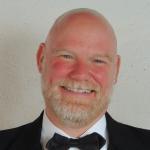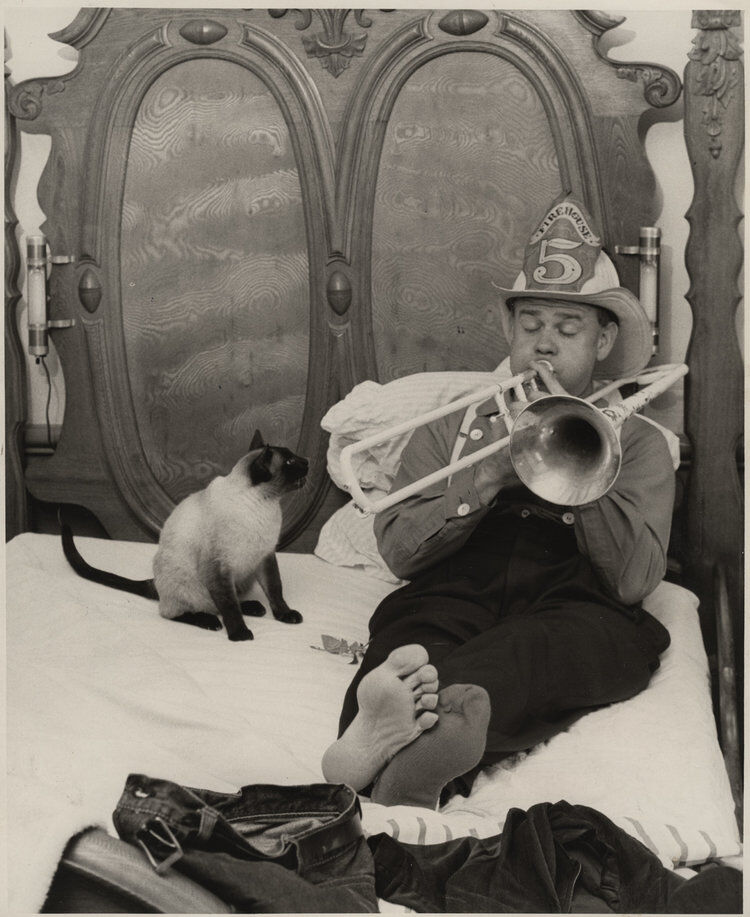
JB: For this installment, we turn to the wild and wonderful world of the Firehouse Five Plus Two. I am happy to welcome Hal Smith back to the column after his furlough last month, especially as this is one of his all-time favorite groups and one of mine as well. Most historical notes you read here will be from the liner notes of Good Time Jazz LPs L-12010-12 and from Hal’s personal observations (he had the pleasure of hearing the band live in SoCal back in the 1960s).
For this inaugural exploration, we go back to the very beginning of the formation of the group, comprised of writers, animators and technicians who worked at Walt Disney studios in Hollywood. These amateur musicians would gather during their lunch break in trombonist Ward Kimball’s office to listen to, and play along with, old phonograph records. The legend has it that one fateful day, the phonograph player broke down, leaving them no choice but to carry on unaided. To their mutual surprise they sounded pretty good! Later, Kimball hosted jam sessions at his house which included jazz luminaries such as Albert Nicholas and Minor Hall (who no doubt inspired and influenced the band as it developed), together with musicians who would become important in the first incarnation of the band: trumpeter Johnny Lucas, banjoist Harper Goff, pianist Frank Thomas, and bass saxophonist Ed Penner.
They sounded good enough, and were having enough fun, that they soon were playing functions in the area, first as “The Hugageedy 8” (referencing their mutual interest in antique cars), then “The San Gabriel Valley Blue Blowers.” Ward purchased and refurbished a 1914 La France fire truck and entered it in a Horseless Carriage caravan to San Diego. Thinking that Dixieland music would enhance the experience, Ward invited some key musicians to make the trip and to play hot jazz along the way. Garbed in red shirts, white suspenders and fire helmets, the famed “Firehouse Five Plus Two” was ready to be launched!
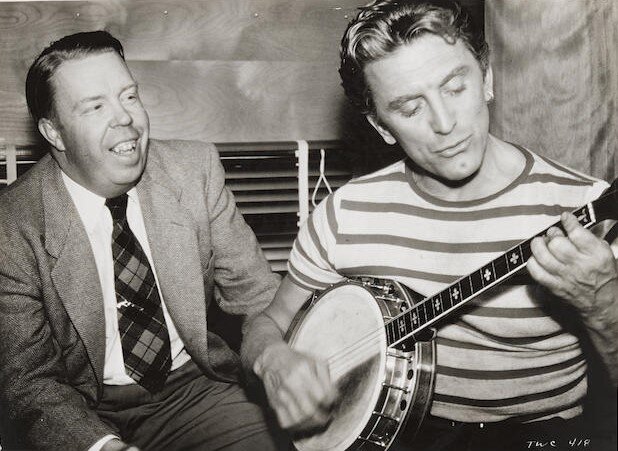
HS: The band was a sensation in Southern California of the late 1940s/early 1950s. Despite the musicians’ day jobs (mostly at Disney Studios), they performed at a wide variety of nightclubs in Los Angeles and Hollywood—as well as playing dances, benefits, concerts and appearances in movies and on television.
JB: Their weekly sessions at the Beverly Cavern (and later the Mocambo) drew famous people to hear and dance to them as well as giving them the opportunity to develop their sound as a band—nothing makes a band play as a tight, cohesive unit like a residency or two!
Now, the group we’ll be exploring this time differs quite a bit from the later, more stable line-up, which consisted of Ward Kimball, leader/trombone; Danny Alguire, trumpet; George Probert, soprano sax; Frank Thomas or K.O. Eckland, piano; Dick Roberts or Billy Newman, banjo; along with several tubists (Ralph Ball, George Bruns, and Don Kinch—who would often join on second trumpet) an a parade of drummers (Monte Mountjoy, Jerry Hamm and Eddie Forrest).
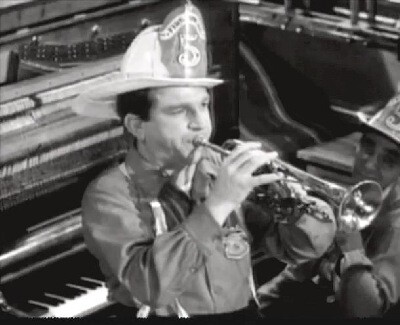
Only Kimball would remain throughout the entire life of the band, with Johnny Lucas, trumpet; Clarke Mallery, clarinet; Harper Goff, banjo; Ed Penner, bass sax (and later tuba); and Jim MacDonald comprising the line-up for the earliest incarnation. This early band has a different sound then the one from 1957 on. Hal, what are some of the major differences you hear with this first version of the band?
HS: The band’s first recording, “Firehouse Stomp” (Kimball and Goff’s interpretation of “Under The Double Eagle”) certainly fits in with the name of the record label: Good Time Jazz! Recorded on May 13, 1949, it is a good, hot performance that a traditional jazz fan would enjoy, with just enough hokum to make it appealing to listeners who wanted a side of entertainment with their jazz.
JB: What an entrance! The fire bell and siren intro immediately told listeners they’d never heard anything like THIS before!! Johnny Lucas provides a strong lead on this inaugural side and his solo plays across the bar a la Armstrong. He wasn’t with the band long, was he, Hal?
HS: There are only four sides by the band with Johnny Lucas on trumpet. On “Fireman’s Lament” Lucas really played a very soulful New Orleans style, with beautiful mute work. Unlike the other recordings from May 13, this one has a minimum of “effects” and this is apparently the sound that Lucas preferred; straight ahead New Orleans, without any gimmicks.
Johnny Lucas left the band before the band’s second recording session, in October, 1949. Obviously, Ward Kimball understood how much the addition of professionals would add to a band otherwise made up of part-time musicians. Ward hired cornetist Danny Alguire and drummer Monte Mountjoy. Both had played in top Western Swing bands—including Bob Wills’ Texas Playboys. Danny’s solid lead playing and Monte’s dependable beat, combined with their excellent musicianship, helped to give the band a crisper, more focused sound. As veterans of the Western Swing circuit, with many shared experiences, Alguire and Mountjoy also became close friends. (Many years later, Mountjoy told bandleader Gene Mayl, “They were the ‘Firehouse Five.’ We were ‘the Two’!”).
One more notable change in the band’s sound came when bass sax man Ed Penner learned to play tuba—in time for the second recording session. The tuba added a fullness and buoyancy to the rhythm section that was not present on the first records. Jeff, can you hear the big difference in the band’s sound between May and October of 1949?
JB: I sure can! Alguire plays such a firm lead (with creative use of mutes on these sides) while never leaving the “amateurs” behind. The chemistry worked and why not?; as you mentioned, Alguire and Mountjoy came from another band that combined heat with fun! I do have to say that while Penner turned into a fine tuba player, part of the emotion of “Fireman’s Lament” came from the moaning held notes of his bass sax.
Before we move from the first session, I have to share that my first LP of the band was “Dixieland Favorites,” recorded between 1958-1960 and featuring soprano saxophonist George Probert. I then bought the three LP’s chronicling the band’s early days. When I heard Clarke Mallery’s clarinet I was floored. On every side he recorded with this aggregation, I loved his combination of virtuosity and earthiness. Too bad he had to leave the band in 1952.
HS: Clarke Mallery started his own band after leaving the FH5. I understand that the name, uniforms and overall sound of his group were similar enough to the Firehouse crew that he gave it up rather than go to court! I am not sure whether the band recorded, but if they did—the records must have been withdrawn from the market relatively quickly. Though apparently Mallery did not play much, if any, music after 1952, he continued to work in animation (Superman, Aquaman, and other cartoons).
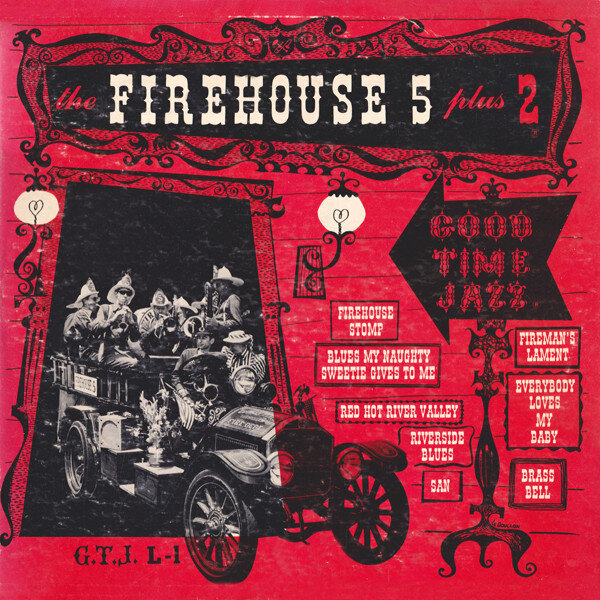 JB: The second session starts with a Frank Thomas composition that highlights the “firehouse” theme, complete with clanging bell intro. “Brass Bell” follows a familiar chord pattern, but the melody and the breaks in the final eight bars make this piece sui generis to my ears. Everyone plays hot on this one!! Penner returns to bass sax for “Everybody Loves My Baby” and you really do miss that tuba; even Adrian Rollini would get lost under the sheer power and volume of this band.
JB: The second session starts with a Frank Thomas composition that highlights the “firehouse” theme, complete with clanging bell intro. “Brass Bell” follows a familiar chord pattern, but the melody and the breaks in the final eight bars make this piece sui generis to my ears. Everyone plays hot on this one!! Penner returns to bass sax for “Everybody Loves My Baby” and you really do miss that tuba; even Adrian Rollini would get lost under the sheer power and volume of this band.
HS: I wonder if “Red (Hot) River Valley” was a nod towards the Bob Wills Texas Playboys repertoire via Danny and Monte. Ward must have liked this one, as the band also performed it on the Bing Crosby radio program, on a Snader Telescription and later on the Mickey Mouse Club. I remember hearing it numerous times at Disneyland at a slower tempo, with drummer Eddie Forrest playing “horse’s hoofs” effects behind Danny’s opening cornet solo. Danny also sang it in later years. We hear Harper Goff’s energetic whistling and also an excellent piano chorus by Frank Thomas.
NEW YEAR, HOTTER SOUNDS
HS: The band was really hitting its stride by 1950—movies, TV, club appearances…and more recordings for Good Time Jazz! They recorded for GTJ in February, July and October of that year and several of the songs would stay in the band’s repertoire right up until the final appearance. There is a little bit of gimmickry on the 1950 recordings, but the band sounds more relaxed and polished. Which of these numbers do you especially like, Jeff?
JB: Let’s list the songs to illustrate the breadth of repertoire the band was exploring in 1950; my favorites are italicized: On 2/18 they recorded “Yes Sir! That’s My Baby,” “Pagan Love Song,” “Tiger Rag,” and “The World Is Waiting For the Sunrise”; on 7/20 they cut “Frankie and Johnny,” “St. Louis Blues,” “Down Where the Sun Goes Down,” and “Copenhagen”; on 10/7 they waxed “12th Street Rag” and “Wabash Blues.” To me, at each session they recorded one side that stood out from the rest, for various reasons, but there are highlights throughout.
On “Yes Sir,” the band’s tempo is the PERFECT Charleston tempo. The group vocal serves two purposes: though not really musical, it conveys the abandon and fun this band shared with its listeners AND features terrific backup work by Danny Alguire. The roadmap for “Pagan Love Song” is inventive, with tuba taking melody on the first chorus with single-string banjo-picking filling in the spaces. Throughout all of these sides, my ear kept returning to Danny Alguire’s authoritative lead, always in the middle register and always hot.
The band nails the tempo again on “Frankie and Johnny:” it stomps so hard you can almost forget the hokum gunshot/Harper Goff scream of agony that opens the track, and the final ensemble gives us a shuffle beat anchored by Penner’s four-to-the-bar tuba that we hear again on the out chorus of “St. Louis Blues.”
For me, the best side of 1950 is “Wabash Blues.” Ward Kimball’s smearing, muted trombone melody is backed by scorching input from Alguire and Mallery, the latter playing his ensuing half chorus in the chalumeau register backed by tremolo banjo and offbeat brass bell! Trombone and clarinet play half note harmonies, accenting beats 1 and 3 and pulsing on beats 2 and 4, behind Alguire’s solo and the band stomps out. As you mentioned, Hal, 1950 produced some polished, swinging and HOT sounds. Are there highlights for you I missed here?
HS: You’re very thorough! I heard “Wabash Blues” many times during the band’s live performance at Disneyland. I would label that tempo as a “slow drag” and it really worked! And as you said, “Yes Sir” is the perfect Charleston tempo. In 1950, stars like Kirk Douglas, Lucille Ball, Lana Turner, Judy Garland, Ginger Rogers, and many more crowded the dance floor at the Mocambo nightclub for the band’s “Charleston contests.” Strangely enough, I don’t remember ever hearing the band play that number at Disneyland!
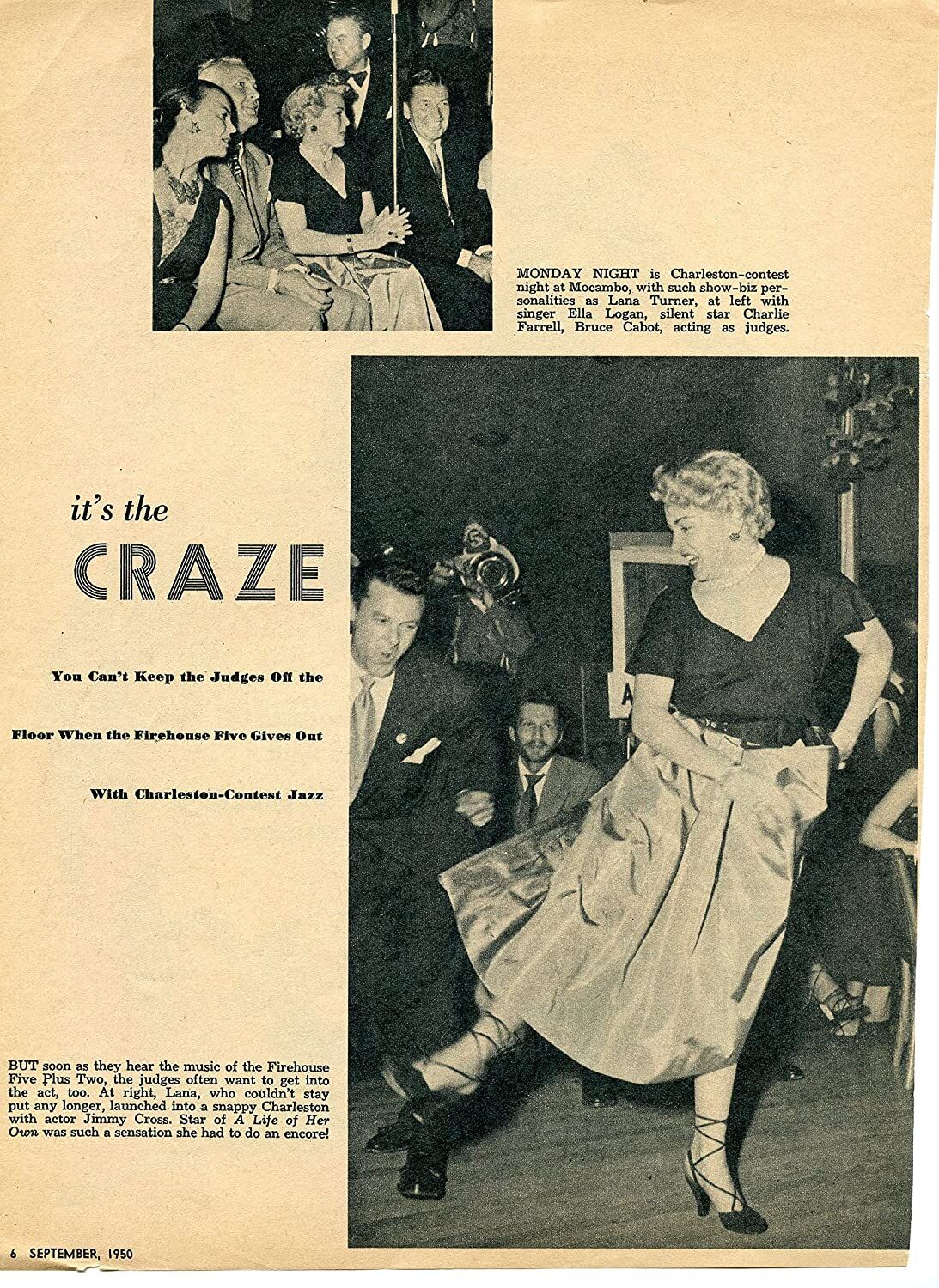 Later on, Danny sang “Frankie and Johnnie” and “St. Louis Blues” on the band’s gigs. It’s too bad that his singing was not included on these sides. I guess that’s due to the 78 rpm time limit. “12th Street Rag” continued to be a banjo feature, with Ward tearing it up on washboard. I remember hearing that one a number of times at Disneyland in the 1960s. Otherwise, my two favorites from the 1950 series are “Copenhagen” and “Down Where The Sun Goes Down.” Danny’s cornet playing on both of those sides very much reminds me of Benny Strickler’s, down to the choice of notes and phrasing. Can you think of anything else we should mention about the band’s 1950 recordings before we wrap up?
Later on, Danny sang “Frankie and Johnnie” and “St. Louis Blues” on the band’s gigs. It’s too bad that his singing was not included on these sides. I guess that’s due to the 78 rpm time limit. “12th Street Rag” continued to be a banjo feature, with Ward tearing it up on washboard. I remember hearing that one a number of times at Disneyland in the 1960s. Otherwise, my two favorites from the 1950 series are “Copenhagen” and “Down Where The Sun Goes Down.” Danny’s cornet playing on both of those sides very much reminds me of Benny Strickler’s, down to the choice of notes and phrasing. Can you think of anything else we should mention about the band’s 1950 recordings before we wrap up?
JB: A few things came to mind after reading your contribution above, Hal. First, I’d have loved to hear Danny sing. I can’t recall if he did solo singing on any subsequent FH5 recordings and I know he is in there during all of the group vocals, but I’m always interested in comparing a horn player’s singing and playing styles. “Slow Drag” is a perfect descriptor for “Wabash” and I would add the aforementioned “Fireman’s Lament” in that category; too bad the band rarely came down to that tempo: they do it beautifully. Second, I love how I’ve been referring to Danny Alguire by his surname and you’ve been referring to him by his first; that comes from having known the man vs merely writing about him. Lucky you!! Third, I hate to be a stick-in-the-mud, but I find (and always have) the sides featuring banjo and washboard are my least favorites; I know they must have brought the house down when presented live at Disneyland and other venues, and nothing to take from Goff’s or Kimball’s playing, but there’s not enough band in those for me.
HS: Well, I have to agree with you regarding most of the banjo and washboard features—although I really enjoyed Dick Roberts’ banjo solos, whether he was featured or not! Danny sang in a very relaxed, easygoing style. You could hear an Oklahoma twang in his voice and he knew how to “sell” a song to the audience with gestures (like pointing fingers, or taking a step forward, to emphasize lyrics). Strangely, his first solo vocal on record with the band doesn’t appear until 1962! Producer Lester Koenig even mentioned that in the liner notes on the Firehouse Five at Disneyland live album.
JB: Let’s stay with this subject next month and move to the remainder of vol. 2 and vol. 3 of the Firehouse Five Story GTJ set, for which I know you have some great stories that are not well known. For my part, I listened to several of these sides two dozen times or more in a row when I first heard them: drove my family CRAZY!! Finally, I’ll end by declaring what an honor it is to share this column with someone who actually played with members of this band while still in their twenties!!! Not too many can make that claim, Hal!
HS: One of my friends was a regular substitute for George Probert with the Firehouse Five! But that took place quite awhile after the period we are currently discussing. Meanwhile, I look forward to our next column, as we move on to 1951 and some of my all-time favorite recordings by the Firehouse Five Plus Two…
JB: Same here. I’ll finish with an observation. As your stand-in Dan Barrett mentioned in last month’s column, the best way to enjoy these columns is to listen to the sides discussed while reading the text. Each title we included in this article is readily available on YouTube and, as Dan put it, “only a click away.” So, faithful readers, happy clicking and happy listening!
Jeff Barnhart is an internationally renowned pianist, vocalist, arranger, bandleader, recording artist, ASCAP composer, educator and entertainer. Visit him online atwww.jeffbarnhart.com. Email: Mysticrag@aol.com
Hal Smith is an Arkansas-based drummer and writer. He leads the El Dorado Jazz Band and the
Mortonia Seven and works with a variety of jazz and swing bands. Visit him online at
halsmithmusic.com




